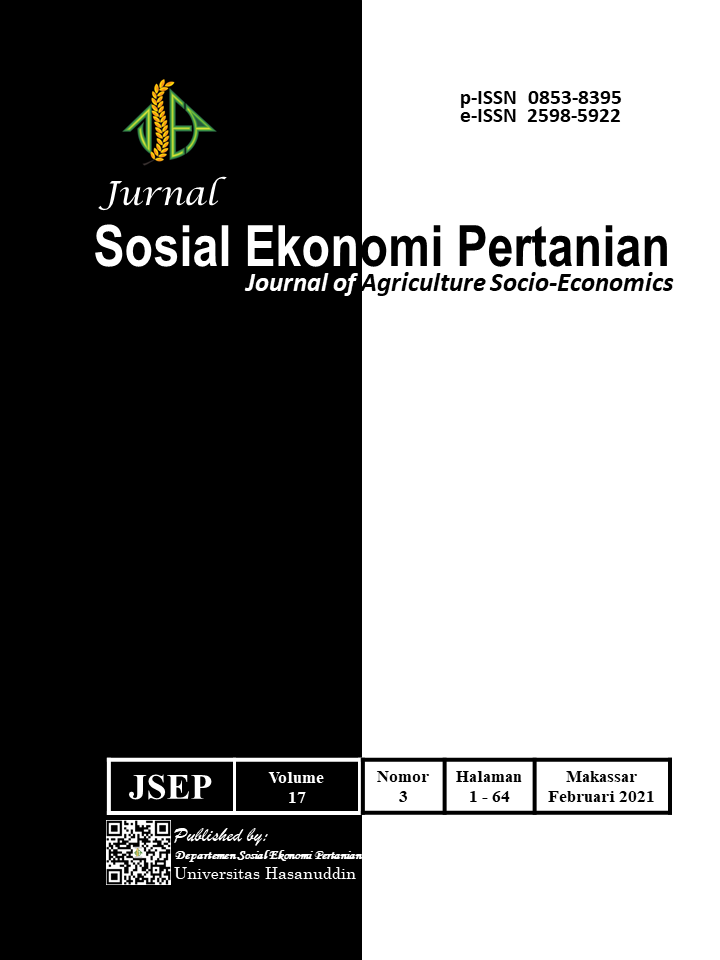Faktor Internal dan Eksternal Penentu Kesejahteraan Petani Jambu Mete di Desa Mata Kapore Kabupaten Sumba Barat Daya
Isi Artikel Utama
Abstrak
Potensi ekspor mete Indonesia cukup besar, namun nilainya masih sangat rendah. Tujuan penelitian ini adalah menganalisis pengaruh faktor internal dan eksternal pada kesejahteraan petani mete. Penelitian ini dilaksanakan di sentra produksi jambu mete yaitu Desa Mata Kapore yang terletak di Kecamatan Kodi Bangedo Kabupaten Sumba Barat Daya. Data dikumpulkan dari 50 petani dengan menggunakan metode wawancara, dan observasi. Petani dipilih dengan metode acak sederhana. Analisis data menggunakan structural equation modeling (SEM) berbasis varians yaitu Partial Least Square (PLS). Faktor eksternal berpengaruh sangat signifikan terhadap kesejahteraan petani, baik secara langsung maupun secara tidak langsung melalui faktor internal. Faktor internal tidak berpengaruh signifikan pada kesejahteraan petani. Untuk meningkatkan kesejahteraan petani, perlu adanya dukungan akses pada modal dan jaminan harga bagi petani jambu mete.
Rincian Artikel

Artikel ini berlisensi Creative Commons Attribution-NonCommercial 4.0 International License.
This works is under Creative Commons Attribution LicenseReferensi
Fauziyah, E., Aniyatussholihah, & Hidayati, D. R. (2017). Strategy of Export Competitiveness Enhancement on Cashew Nut Commodity. JEJAK Journal of Economics and Policy, 10(2), 302–316. https://doi.org/http://dx.doi.org/10.15294/ jejak.v10i2.11295.
Guledgudda, S. S., Patil, B. L., & Rajur, B. C. (2014). Export performance of Indian cashewnut – An analysis. Economic Affairs, 59(4), 669–674. https://doi.org/10.5958/ 0976-4666.2014.00041.2
Hakim, N. (2018). Jurnal mega aktiva. Jurnal Mega Aktiva, 7 (April), 1–10.
Hartati, G. A. R., Budhi, M. K. S., & Yuliarmi, N. N. (2017). Analisis faktor-faktor yang mempengaruhi kesejahteraan petani di Kota Denpasar. E-Jurnal Ekonomi Dan Bisnis, 6(4), 1513–1546.
Indrawanto, C. (2004). Peningkatan Daya Saing Industri Mente Indonesia Melalui Pembentukan Klaster Industri Mente. Perspektif, 3(1), 15–23.
Kurniawan, B. P. Y. (2016). Strategi dan Prospek Pengembangan Jambu Mete (Anacardium occidentale. L) Kabupaten Jember. Jurnal Manajemen Teori dan Terapan, 9(3), 242–258
Pudjiastuti, A. Q. (2014). Perubahan Neraca Perdagangan Indonesia Sebagai Akibat Penghapusan Tarif Impor Gula. Agriekonomika, 3(2), 106–116.
Pudjiastuti, A. Q., Anindita, R., Hanani, N., & Kaluge, D. (2013). Effects of Sugar Price Increase in Indonesia. Oeconomica, 58(1), 28–39. https://doi.org/http:// studiaoeconomica.ubbcluj.ro/volumes.html
Pudjiastuti, A. Q., & Kembauw, E. (2018). Sugar Price Policy and Indonesia’s Trade Balance. Journal of Advanced Research in Law and Economics, 8(8). https://doi.org/10.14505/jarle.v8.8(30).26
Zahir, N., & Sanawiri, B. (2018). Analisis Daya Saing Kacang Mete Indonesia di Pasar Internasional ( Studi tentang Kacang Mete Indonesia Tahun 2011-2015 ). Jurnal Administrasi Bisnis (JAB), 54(1), 66–73.
Yusria, W. O. (2010). Keadaan Ekonomi Rumahtangga Petani Jambu Mete Di Kabupaten Buton Sulawesi Tenggara. Jurnal AGRISEP, 9(2), 109–119. https://doi.org/10.31186/jagrisep.9.2.109-119

